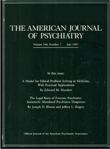TO THE EDITOR: Olanzapine, an atypical antipsychotic, has been found superior in efficacy to haloperidol for the treatment of schizophrenia, with fewer extrapyramidal side effects (
1,
2). The current guidelines for olanzapine use in schizophrenic patients suggest a maximum dose of 20 mg/day; the safety of doses above this level have not yet been evaluated in clinical trials. However, many patients, including those classified as having responded to olanzapine, continue to have substantial psychopathology after 6 weeks of treatment. The primary purpose of this letter is to describe the treatment-emergent side effects that result from the administration of high doses of olanzapine to patients with treatment-refractory schizophrenia.
Eight male patients with chronic schizophrenia and refractory symptoms were treated with a regimen of olanzapine that began at 5 mg/day and was titrated up to 30 mg/day in five patients and to 40 mg/day in three patients. The patients' mean age was 43 years (range=29–61), and the mean length of the current hospitalization was 96 months (range=9–211). Before assessment, patients had been receiving high-dose olanzapine for at least 12 days. Extrapyramidal side effects were assessed by using the Modified Simpson Angus Scale (
3); other side effects, including blood dyscrasias, were assessed by patient interview and chart review.
Of these eight patients, five were found to have acute extrapyramidal side effects (akathisia [N=1], parkinsonism [N=2], both akathisia and parkinsonism [N=2]). All symptoms were mild; only one patient required treatment with benztropine and propranolol. One additional patient had questionable parkinsonism. Mild daytime drowsiness and dry mouth were reported by five and three patients, respectively. No other side effect was reported by more than one patient. When questioned about how side effects with olanzapine compared with all previous standard antipsychotic medications, four patients reported feeling better, three felt the same, and one felt worse.
The treating psychiatrists reported that all patients continued to manifest prominent psychotic symptoms at these doses. However, social functioning improved in four of the eight patients, with two being markedly more organized in thought and behavior.
Overall, olanzapine treatment at doses greater than 20 mg/day was well tolerated, although a greater prevalence of extrapyramidal side effects was found at these doses (
4). The efficacy of olanzapine at high doses for some refractory schizophrenic patients is suggested by these cases but remains to be firmly established.

